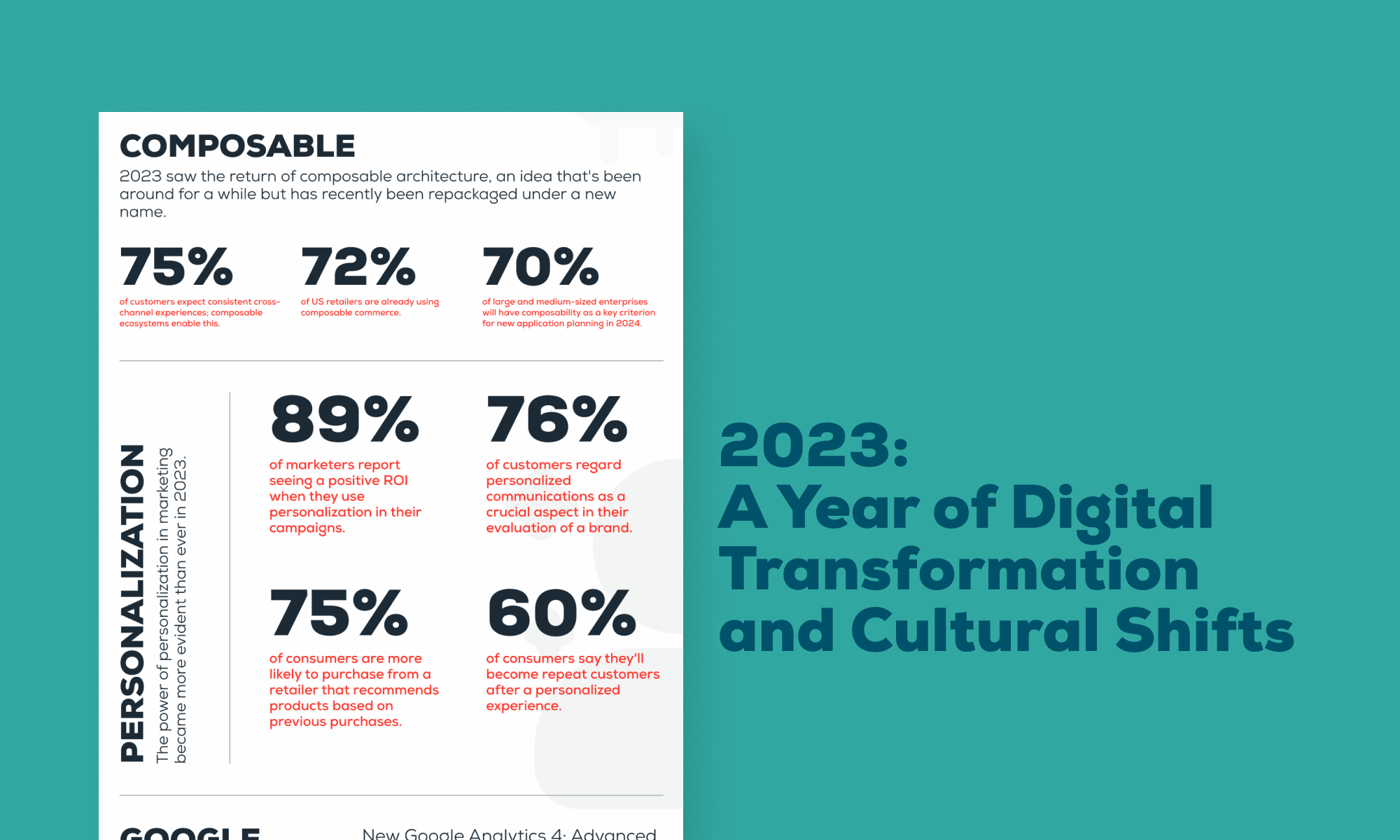Last week, we gave you a sneak peek with our infographic on 2023's trending topics. Today, let's take that conversation further. Ever wondered how Drupal is reshaping web development? Or how the post-COVID-19 world is balancing the blend of home and office work? We're about to dive into these topics and more.
This isn't just about the buzz around Artificial Intelligence or the surge in video content – it's about understanding their real impact. We're also going to explore the rise of flexible architectures in technology, the increasing importance of personalization in marketing, and how Google Analytics 4 is changing our approach to web data.
The Drupal Transformation
The Drupal community in 2023 was a hub of vibrant activity and innovation, reflecting the platform's ongoing evolution and impact. This year, the community saw a significant milestone with the decommissioning of Drupal 9, a move that not only marked the end of an era but also set the stage for future growth and development. The announcement of Drupal 7's end-of-life for 2025 sparked discussions and preparations for upcoming transitions, emphasizing the community's forward-thinking approach. One of the most exciting developments was the first-ever AI integration in Drupal, showcasing a commitment to embracing cutting-edge technology. This integration is poised to revolutionize how the community and developers engage with the platform, offering new possibilities for efficiency and creativity. Additionally, the release of the Drupal 10.2 and 10.3 roadmaps brought a wave of anticipation, with promises of improved site builder proficiency, enhanced editorial experiences, and reduced maintenance costs. These updates and upgrades reflect a year where the Drupal community not only adapted to changing technological landscapes but also played a pivotal role in shaping them, ensuring that Drupal remains at the forefront of web development innovation.
Hybrid Work: The New Norm and Its Impact
In 2023, the concept of hybrid work transitioned from a temporary solution to a new norm, profoundly impacting corporate culture and employee dynamics. As the world gradually adjusted to post-pandemic realities, a significant 90% of organizations embraced hybrid work models, blending remote and in-office arrangements. This shift was indeed about location, but also flexibility; it represented a deeper change in work-life balance, communication strategies, and organizational structures. However, the transition wasn't without its challenges. Some companies, in an attempt to revive pre-pandemic work environments, mandated a return to the office, leading to mixed reactions from employees who had adapted to and often preferred the flexibility of remote work. This tug-of-war between remote and in-office work underscored a broader conversation about productivity, employee satisfaction, and the future of work. The year 2023 thus became a pivotal moment for companies to reassess and redefine their work policies, striving to find a balance that catered to both organizational goals and employee well-being in this new era of hybrid work.
AI: Reshaping Business and Society
Generative AI emerged as a key technological driver in 2023, catalyzing significant changes in both business and social landscapes. A notable 54% of firms reported experiencing cost savings and efficiency gains with AI integration in their IT and business processes. In the realm of marketing, companies that embraced AI saw a remarkable 15-20% increase in ROI, while 60% of marketers acknowledged AI's role in fostering more customer-centric experiences.
The impact of AI on businesses and individual workers in 2023 was profound. Companies leveraging AI tools experienced enhanced operational efficiencies as well as a transformation in their strategic decision-making processes. AI's predictive analytics and automation capabilities enabled businesses to anticipate market trends and customer needs more accurately, leading to more informed and agile business strategies. For individual workers, AI tools brought about a paradigm shift in job roles. Routine tasks were automated, allowing employees to focus on more creative and strategic aspects of their work, thereby enhancing job satisfaction and productivity.
The proliferation of AI tools also significantly changed the dynamics within companies. Decision-making became more data-driven, and collaboration between different departments, such as marketing and IT, intensified to leverage AI's full potential. In terms of website interaction, AI revolutionized user experience with personalized content, predictive search, and responsive chatbots, making websites more engaging and user-friendly.
However, the surge of AI tools in the market also posed a challenge. With hundreds of options, it became crucial for businesses and individuals to choose tools that align with their specific needs without getting lost in a sea of possibilities. To avoid wasting time on trial and error, a focused approach to selecting AI tools based on clear objectives and desired outcomes was essential. In navigating this vast landscape of new tools, aggregate websites like Futurepedia.io became invaluable resources. They offer a streamlined way to discover and evaluate tools, with categories, filters, and user ratings that simplify the selection process. By leveraging such platforms, everyone can efficiently find AI solutions tailored to their specific needs, saving time and ensuring they make informed decisions.
For those navigating this landscape, here are 5 AI tools we recommend to get started:
- Salesforce Einstein: For AI-powered CRM insights and customer predictions.
- Adobe Sensei: For enhancing creative workflows and digital experiences.
- MarketMuse: For AI-driven content research and strategy.
- Drift: For conversational marketing and AI-driven chatbots.
- Acrolinx: For content governance and AI-powered content optimization.
And for developers, these are the top 5 AI tools:
- OpenAI GPT-4: For natural language processing and generative tasks.
- IBM Watson: For building AI-powered applications and data analysis.
- Azure AI: For a comprehensive suite of AI services on the cloud.
- Google AI Platform: For end-to-end machine learning model development.
- Rasa: For creating sophisticated AI chatbots and conversational agents.
In 2023, AI not only reshaped how businesses operate and individuals work but also how they select and utilize technology, emphasizing the need for strategic and informed choices in the ever-growing AI landscape.
As we mentioned earlier, the Drupal community announced its first-ever integration with OpenAI in 2023. The community is actively working to launch more exciting modules, expanding the possibilities of AI within Drupal. For the latest updates and innovations, keep an eye on the Drupal artificial intelligence (AI) community initiative!
The Dominance of Video Content
With constantly evolving content creation and consumption patterns, video content has risen to prominence, asserting its dominance in digital media. This shift is not just a trend but a fundamental change in how information is consumed and shared. The average person now spends approximately 17 hours a week watching online videos, a testament to the medium's captivating appeal. This engagement with video content is not just about entertainment; it's a reflection of the changing preferences and behaviors of consumers in a fast-paced digital world. Adding to this, a significant statistic reveals that 50% of social media users prefer video over other types of content, further underscoring the growing influence and preference for video in our daily digital interactions.
The preference for video over other types of content is further highlighted by its shareability. Video content is 52% more likely to be shared than other types, indicating its effectiveness in capturing attention and encouraging engagement. This aspect is particularly crucial in an era where social media platforms dominate and the ability to go viral can significantly impact a brand or message's reach and influence.
Moreover, the effectiveness of video content is also evident in how it aids in information retention. Studies show that viewers retain 95% of a message when it's watched on video, compared to just 10% through text. This stark difference underscores the power of visual and auditory elements in facilitating better understanding and recall. In a world inundated with information, the ability of video to convey messages more effectively makes it a powerful tool for communication and education.
In the business-to-business (B2B) sector, the impact of video content has been particularly noteworthy. About 71% of marketers have turned to video marketing, recognizing its potential to enhance brand messaging and product understanding. The use of video in marketing strategies is not just about creating appealing content; it's about building narratives that resonate with the audience, and providing insights into products and services in a way that is both informative and engaging. The result of this strategic incorporation of video content is evident, with 96% of marketers in the B2B sector reporting an enhanced understanding of their products and services among users. This statistic clearly indicates video's effectiveness in improving communication between businesses and their clients.
The rise of video content as the preferred medium in the digital landscape is a reflection of broader changes in technology and consumer behavior. With the increasing accessibility of high-speed internet and the proliferation of smartphones, creating and consuming video content has become more convenient than ever. People are now more inclined to engage with content that is not only informative but also visually appealing and easy to digest. This shift towards video content is reshaping marketing strategies, educational methodologies, and how information is disseminated, making it an indispensable tool in the digital era. As we move forward, the role of video in shaping our understanding and interaction with the digital world is only set to grow, solidifying its status as the emperor of digital content.
The Rise of Composable Architecture
In 2023, the digital landscape witnessed a significant resurgence in the concept of composable architecture, a trend that has been gaining momentum, particularly in the retail sector. With 72% of US retailers already leveraging composable commerce and 70% of large and medium-sized enterprises planning to include composability as a key criterion for new application planning by 2024, it's clear that this approach is more than just a fleeting trend. Composable architecture, in essence, is about assembling software components as seamlessly as one would in a game of digital Lego, allowing for a more flexible, tailored approach to building digital ecosystems.
This trend toward composable architecture is not entirely new; it's an age-old concept that has found renewed relevance in today's fast-paced, digitally-driven world. It represents a shift from monolithic, one-size-fits-all solutions to a more modular, adaptable approach. This flexibility is crucial in an era where businesses need to rapidly adapt to changing market demands and consumer behaviors. Composable architecture allows businesses to integrate distinct software components into their tech stack, customizing how they work together to meet specific needs. This approach is akin to selecting the best tool for each job, ensuring that each component of the digital ecosystem is optimized for its intended purpose. Significantly, this shift towards a more integrated and flexible architecture is driven by customer expectations; with 75% of customers expecting a consistent experience across all channels, adopting a composable digital ecosystem becomes essential. It enables organizations to seamlessly integrate their systems and data, facilitating a personalized and cohesive customer journey across various touchpoints.
The rise of composable architecture also reflects a broader shift in how businesses approach digital transformation. It's a move away from traditional, rigid systems towards more agile, scalable solutions. This flexibility is particularly beneficial for businesses looking to enhance their online presence, streamline operations, or expand their digital offerings. By adopting a composable approach, businesses can build digital platforms that are not only more efficient and effective but also better aligned with their unique goals and challenges.
As we delve deeper into the world of composable CMS and its implications for digital strategy, it's evident that this concept, while seemingly new, has been a part of the technological landscape for ages. Drupal, for instance, has long exemplified the principles of composability with its open, adaptable nature. For a more comprehensive understanding of how composable architecture is reshaping the digital world and why it's more than just a trendy term, navigate to this blog post next.
Personalization: The Key to Customer Engagement
In 2023, the marketing landscape witnessed a paradigm shift with the rising prominence of personalization, a strategy that has redefined customer engagement and brand loyalty. This year, an overwhelming 89% of marketers reported experiencing a positive return on investment from personalization in their campaigns, underscoring its effectiveness in today's competitive market. The essence of personalization in marketing lies in its ability to create a unique, tailored experience for each customer, making them feel valued and understood. This approach goes beyond traditional marketing techniques by leveraging data analytics and customer insights to deliver relevant content, offers, and product recommendations.
The impact of personalization on consumer behavior was profound. About 76% of customers indicated that personalized communications were a significant factor in their brand preferences. This shift is indicative of a broader trend where customers seek more than just transactions; they desire relationships with brands that recognize their individual needs and preferences. Personalization, therefore, becomes a critical tool in building these relationships, fostering a sense of connection and trust between the brand and its customers.
Moreover, the strategy's effectiveness in driving customer loyalty was evident, with 60% of consumers stating they would become repeat customers following a personalized shopping experience. This statistic highlights the long-term value of personalization in cultivating customer loyalty and repeat business. In an era where consumers are bombarded with generic advertising and overwhelming product choices, personalization cuts through the noise, offering a curated experience that resonates with individual preferences and lifestyles.
The emphasis on personalization in 2023 also reflected a larger shift in marketing strategies, where the focus has moved from mass marketing to micro-targeting. Brands that successfully implemented personalized marketing strategies not only saw immediate gains in terms of sales and engagement but also established a foundation for sustainable growth and customer retention. 75% of consumers are more likely to purchase from a retailer that recognizes them by name and recommends products based on previous purchases. This statistic highlights the significant impact of personalization on consumer behavior and decision-making. As we look towards the future, the role of personalization in marketing is set to become even more integral, with advancements in AI and data analytics further enhancing the ability of brands to deliver personalized experiences at scale, catering to the individual preferences and histories of their customers.
Google Analytics 4 (GA4): The New Standard in Analytics
In 2023, Google Analytics 4 (GA4) emerged as the new benchmark in the realm of web analytics, revolutionizing how businesses understand and interact with their online audience. With its advanced event-tracking capabilities, GA4 offered a more nuanced and comprehensive view of user behavior, enabling businesses to glean deeper insights than ever before. This leap in analytics technology was not just about collecting more data; it was about understanding the stories behind the numbers, providing a clearer picture of how users engage with websites and digital content. The widespread adoption of GA4, used by 89.5% of websites with analytics tools, signified a major shift in the digital analytics landscape. The United States, leading this trend with approximately 3.2 million websites utilizing GA4, demonstrated the tool's critical role in shaping digital strategies.
As we move into 2024, the impact of GA4 in 2023 offers valuable lessons and forecasts for the future of digital analytics. The rapid evolution of the digital landscape necessitates tools that not only track user interactions but also interpret these interactions in a meaningful way. GA4's ability to provide detailed insights into user behavior and preferences is crucial for businesses looking to adapt and thrive in an increasingly digital world. The trends and statistics from 2023, highlighted by the adoption of GA4, underscore the importance of staying ahead in the analytics game, ensuring that businesses are equipped with the right tools to navigate the ever-changing digital terrain successfully.

Embracing Change
Reflecting on the whirlwind that was 2023, it's clear that we've witnessed a seismic shift in the digital and cultural landscapes. This year wasn't just about technological advancements; it was a story of adaptation, innovation, and rethinking the way we interact with the digital world. From Drupal's evolution to the normalization of hybrid work models, the transformative power of AI, the reign of video content, the strategic shift towards composable architecture, and the undeniable impact of personalization in marketing, 2023 has been a year of groundbreaking changes.
But what does all this mean as we step into 2024? For one, the adoption of Google Analytics 4 (GA4) has set a new benchmark in understanding digital footprints, signaling a future where data isn't just numbers, but narratives that guide business strategies. We're moving into an era where the line between technology and humanity blurs, where AI isn't just a tool but a collaborator that enhances our creativity and efficiency.
The rise of video content, more than just a trend, reflects a deeper shift in consumer behavior. It's a vivid reminder that in the digital age, engagement is king. Brands and content creators need to think beyond words on a screen; it's about crafting experiences that resonate, inform, and entertain.
As for composable architecture, it's not just a buzzword; it's a philosophy. It's about building systems that are as dynamic and adaptable as the markets they serve. This approach will likely become even more crucial in 2024 as businesses seek to navigate an ever-changing technological landscape.
And let's not forget personalization – it's no longer a nice-to-have, it's a must-have. The brands that succeed in 2024 will be those that understand their customers not as segments, but as individuals, with unique preferences and behaviors.
In essence, 2023 has laid the groundwork for a 2024 that promises even more innovation and transformation. We're not just riding the wave of change; we're shaping it. As we move forward, the key will be to stay adaptable, keep learning, and always be ready to embrace the new possibilities that lie ahead in this exciting digital journey.


